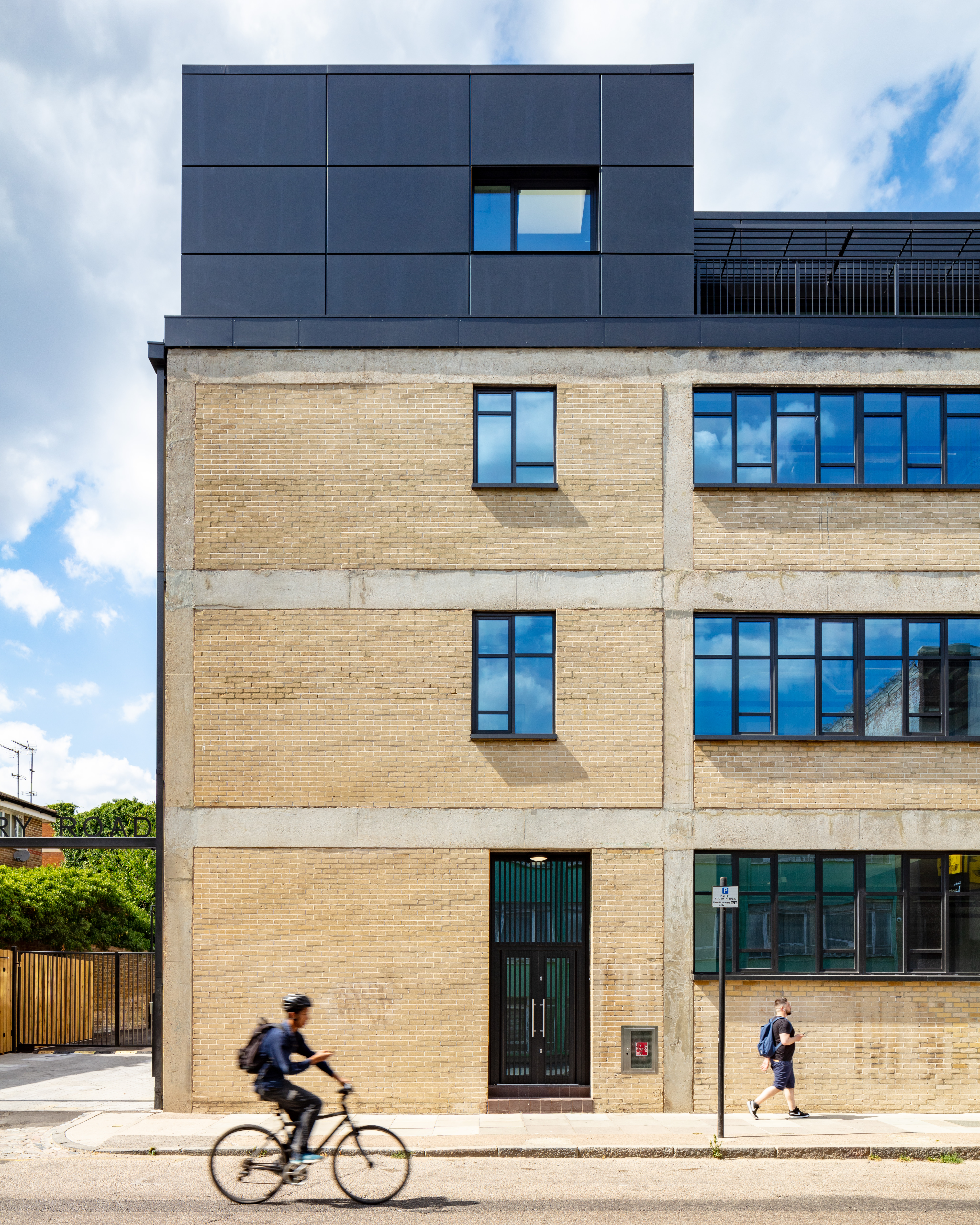Adaptive reuse: How old stories find new expression in North London
Boon Brown were approached by the City of London Corporation in 2019 to take on the renovation of 100 Brewery Road, located in one of Islington’s less salubrious corners. Previously used in the production of clothing, the existing mid-century, light industrial building was to be converted to 4700 m² of commercial space. The refurbishment included the creation of new access and circulation to the rear of the building, the creation of additional floor area through infilling of inset corners and a new third floor level of office space, with external terraces and newly introduced sustainable measures on the roof above.
Design approach
The design aspects of the project developed from two interrelated conceptual questions:
- On what reasonable basis can a building assume a new use?
- To what extent can it adapt to further functional changes?
These questions contribute to the enrichment of the current trend of adaptive reuse. This is an evolving concept and cannot be easily distinguished from the terms and practices of renovation or refurbishment, since each is aimed at improving the given conditions of an existing building and revitalising the structure, to ensure the preservation of the authentic character of the building, in accordance with a new use. However, the questions point to a certain difference; they imply our proactive attitude towards the nature of change. While strategically pursuing sustainable development in terms of both ecological and economic viability, the stance places a tactical focus on enriching values, more than identity, and emphasising performance more than mere existence.
Both ‘adoption’ and ‘adaptation’ positively embrace the given conditions as factors to be preserved and further interpreted to benefit from their inherent properties. By analysing and examining the original building, its use and subsequent disuse, the various attributes were considered and allowed to influence the vision of what it was to become. At the same time, the potential future use and type of tenants who might be attracted had to be acknowledged; bringing a modern aesthetic and such matters as sustainability and accessibility to the fore. Flexibility naturally played a role too, from both a commercial and user-fit perspective. Mediating between these supposed constraints and opportunities, the spatial, structural and material aspects were further examined and explored.
Spatial aspects
The existing building had become almost uninhabited and with declining value it was falling out of step with the surrounding urban context and the broader shifts in its economic paradigm. The project addressed spatial atrophy and renewal, seeking to accommodate diverse, lively activities, focusing on the task of configuring the newly expanded spaces. By taking the logic of the existing spaces into the new parts, to drive their contextual design response, it was then possible to implement a reciprocal reconfiguration of the existing spaces by adapting them to suit the new relationships. In this way we were able to establish a plausible link between the client and the users, in particular between what the landlord expected and what the tenants might expect, the latter therefore acting as the known variable.
And we sought to go further than simply considering how the spaces might be partitioned for flexible letting, but rather to imagine the production of accommodation that should be marketable over time, fundamentally creating a readily consumable spatiality.
The principle of production, guided by the upward arrangement of new uses, from warehouse distribution areas on the ground floor, to office above, thus shaped the vertical transition of the building’s character. It moved from an industrial hardware environment, to a robust yet comfortable, software supporting ambience. The transition was complemented by the horizontal relocation of the entrances for both pedestrians and vehicles, via perimeter circulation road, to the rear of the building. Simultaneously, the verticality and lateral relationship between old and new is celebrated by a full-height, front lit, atrium shaft which rising above the reception and spatially connects all floors. This also signals the new entrance externally, by virtue of the tall, strip of translucent material that introduces natural light deep within the added core. In effect, the compact core, offset to the rear, frees up the floorplates, to maximise not only the lettable areas but also the sense of space. This is most apparent at third floor level where the accommodation fluidly stretches out across the new terraces, offering panoramic views of the city laid out beyond.

Structural aspects
The building had remained static and unused for a significant period. Structural assessment undertaken by the engineers determined the need for a dual strategy; of reinforcement of the existing fabric, such that it could easily adapt to the new live and dead load demands, with integration of the infill parts and additional level, which imposed their own loads, while also providing a stabilising effect against lateral loading.
Given the original building lacked vertical bracing and previously relied on rigid connections for stiffness, the introduction of the infill parts provided a cost-effective solution to this part of the structural challenge. Importantly, this also further enhanced the future flexibility in terms of use and therefore the ongoing viability of the building.

Material aspects
With its identity, as well as value, decreasing over time, the building was left to deteriorate, unnoticed. Tackling the material depreciation of the building and reinvigorating it by the architectural response, its capacity for sensory stimulation has been reinstated, while the project came to unfold in the melding of various interior and exterior factors.
Internal treatment provides a rational core and Cat A office setting, allowing incoming tenants to fit out their spaces flexibly, yet with some gently derived definition. In the landlord parts, the project kept an industrial character with the new structural elements painted in matt orange, while the services are largely exposed in core areas and on office floors. The core stairs and secondary metal work are finished in black, offset against plain white walls, while polished concrete floors run through the core and metal access floors eagerly await tenant installations.
Externally, the internal aesthetic continues, with a modern industrial feel in the applied matt black aluminium cladding, used to envelop new parts. The existing pale yellow brick façade panels and the grid of concrete encased posts and beams which frame them, have been gently restored, while still articulating the urban context and building’s historic presence. Carefully inserted new window units meet today’s standards thermally and acoustically but also allow user control with opening for natural ventilation a retained possibility. The new top floor, largely set back from the lower façade, generates external amenity as terraces which provide physical relief to the building mass and sensory relief to the occupants. Above this sits external plant and a field of PV cells laid out in rows over a green roof background, providing the critical sustainable measures to be expected today.
The conceptual issues on adoption and adaptation were examined in spatial, structural and material aspects in order to capture a certain disparity between the existing and newly introduced conditions; to establish their balance and to facilitate their multilateral transition.
Appropriately, the result is a commercial thread, stitched into the surrounding urban fabric and further woven into the patchwork of the London real estate market. The resultant product offers the immediate benefit of architectural, urban improvement and has gained a higher value, together with a refreshed identity of its own. However, the design strategies were developed and deployed to achieve long-term effectiveness, rather than immediate reward, though this is welcome too. The fundamental value of the project is as diverse as it is delicate and, somewhat paradoxically, is intended to surpass its currently designated identity. The subtle meaning can become more explicitly defined and potentially increasingly attractive over time, as the future customer-tenant relationship develops and the cycle of adaptive reuse goes on.
Boon Brown is an appointed company and features on our Architect Design Services (ADS1.1) framework.
![]()


